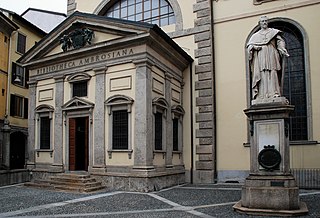Ammonius Hermiae was a Greek philosopher from Alexandria in the eastern Roman empire during Late Antiquity. A Neoplatonist, he was the son of the philosophers Hermias and Aedesia, the brother of Heliodorus of Alexandria and the grandson of Syrianus. Ammonius was a pupil of Proclus in Roman Athens, and taught at Alexandria for most of his life, having obtained a public chair in the 470s.

Angelo Maria Bandini was an Italian author and librarian born in Florence.

Franz Heinrich Ludolf Ahrens was a German philologist.

The Biblioteca Ambrosiana is a historic library in Milan, Italy, also housing the Pinacoteca Ambrosiana, the Ambrosian art gallery. Named after Ambrose, the patron saint of Milan, it was founded in 1609 by Cardinal Federico Borromeo, whose agents scoured Western Europe and even Greece and Syria for books and manuscripts. Some major acquisitions of complete libraries were the manuscripts of the Benedictine monastery of Bobbio (1606) and the library of the Paduan Vincenzo Pinelli, whose more than 800 manuscripts filled 70 cases when they were sent to Milan and included the famous Iliad, the Ilias Picta.

Franz-Valéry-Marie Cumont was a Belgian archaeologist and historian, a philologist and student of epigraphy, who brought these often isolated specialties to bear on the syncretic mystery religions of Late Antiquity, notably Mithraism.
Antiochus of Athens was an influential Hellenistic astrologer who flourished sometime between the late 1st and mid 2nd century AD. There is some disagreement as to when he lived and wrote. Franz Cumont and others have argued that he lived as early as the 1st century BC, while David Pingree placed him as late as the end of the 2nd century AD. The one agreed datum is that Antiochus is referenced by Porphyry, and so Antiochus must have lived before the death of Porphyry.

Franz Boll was a German scholar and contemporary of Cumont. He became Professor of Classical Philology at the University of Heidelberg.
Minuscule 1253, Θε64. It is a Greek minuscule manuscript of the New Testament on paper. Palaeografically it has been assigned to the 15th century. The manuscript is lacunose.
Hans Georg Herwart von Hohenburg was a Bavarian statesman and scholar, and a patron and correspondent of Johannes Kepler.

Ophiuchus (⛎︎) (, has sometimes been used in sidereal astrology as a thirteenth astrological sign in addition to the twelve signs of the tropical zodiac. The constellation Ophiuchus, as defined by the 1930 International Astronomical Union's constellation boundaries, is situated behind the sun from November 29 to December 18.
Lectionary 274, designated by siglum ℓ274 is a Greek manuscript of the New Testament, on paper. Palaeographically it has been assigned to the 16th century. It used to be known as Nanianus 202. The manuscript has complex contents.

Minuscule 833, Θε421, is a 14th-century Greek minuscule manuscript of the New Testament on paper. The manuscript has complex contents.

Minuscule 832 (in the Gregory-Aland numbering), A127 (von Soden), is a 10th-century Greek minuscule manuscript of the New Testament on parchment. The manuscript has no complex contents.

Minuscule 834, Θε422, is a 14th-century Greek minuscule manuscript of the New Testament on parchment. The manuscript has complex contents.

Minuscule 835, Θε38, is a 13th-century Greek minuscule manuscript of the New Testament on parchment. The manuscript has complex contents.

Minuscule 836, Θε46, is a 14th-century Greek minuscule manuscript of the New Testament on paper. The manuscript has not complex contents, it lacks Gospel of Luke.
Lectionary 300 (Gregory-Aland), designated by siglum ℓ300 is a Greek manuscript of the New Testament, written on parchment. Palaeographically it has been assigned to the 11th-century. The manuscript is written in gold and contains Gospel lessons for selected days. It was named as "Gospel of Theodosius".
Hipparchicus is one of the two treatises on horsemanship by the Athenian historian and soldier Xenophon (circa 430–354 BC). Other common titles for this work include The cavalry commander and The cavalry general. The other work by Xenophon on horsemanship is Περὶ ἱππικῆς, Perì hippikēs, usually translated as On horsemanship, De equis alendis or The Art of Horsemanship. The title De re equestri may refer to either one of the two works. Hipparchicus deals mainly with the duties of the cavalry commander (hipparchus), while On horsemanship deals with the selection, care and training of horses in general.

Minuscule 1187, ε 1083, is an 11th-century Greek minuscule manuscript of the New Testament on parchment. It has marginalia. The manuscript has survived in complete condition. It is housed in the Saint Catherine's Monastery.
This page is based on this
Wikipedia article Text is available under the
CC BY-SA 4.0 license; additional terms may apply.
Images, videos and audio are available under their respective licenses.












